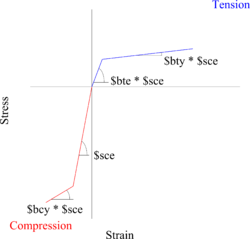AxialSp Material: Difference between revisions
Jump to navigation
Jump to search
(Created page with '{{CommandManualMenu}} This command is used to construct a uniaxial AxialSp material object. This material model produces axial stress-strain curve of elastomeric bearings. {| ...') |
No edit summary |
||
| (One intermediate revision by the same user not shown) | |||
| Line 35: | Line 35: | ||
[[Image: | [[Image:AxialSp_note1.png|250px]] [[Image:AxialSp_note2.png|250px]] | ||
---- | ---- | ||
| Line 44: | Line 44: | ||
[[Image:AxialSp_StressStrain.png|300px]] | [[Image:AxialSp_StressStrain.png|300px]] | ||
---- | |||
Code Developed by: <span style="color:blue"> mkiku </span> | |||
Latest revision as of 06:04, 26 January 2015
- Command_Manual
- Tcl Commands
- Modeling_Commands
- model
- uniaxialMaterial
- ndMaterial
- frictionModel
- section
- geometricTransf
- element
- node
- sp commands
- mp commands
- timeSeries
- pattern
- mass
- block commands
- region
- rayleigh
- Analysis Commands
- Output Commands
- Misc Commands
- DataBase Commands
This command is used to construct a uniaxial AxialSp material object. This material model produces axial stress-strain curve of elastomeric bearings.
| uniaxialMaterial AxialSp $matTag $sce $fty $fcy <$bte $bty $bcy $fcr> |
| $matTag | integer tag identifying material |
| $sce | compressive modulus |
| $fty $fcy | yield stress under tension ($fty) and compression ($fcy) (see note 1) |
| $bte $bty $bcy | reduction rate for tensile elastic range ($bte), tensile yielding ($bty) and compressive yielding ($bcy) (see note 1) |
| $fcr | target point stress (see note 1) |
NOTES:
1) Input parameters are required to satisfy followings.
$fcy < 0.0 < $fty
0.0 <= $bty < $bte <= 1.0
0.0 <= $bcy <= 1.0
$fcy <= $fcr <= 0.0
EXAMPLE:
Code Developed by: mkiku


